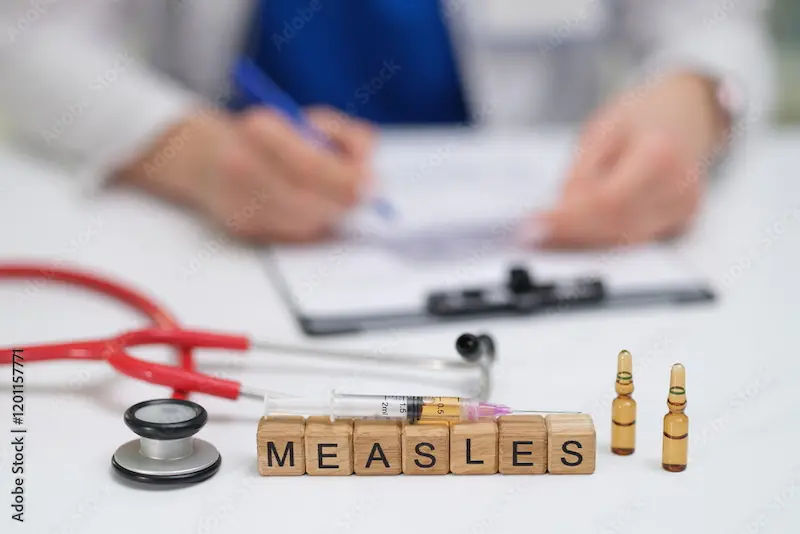Measles Signs: Understanding the Causes and Contagious Stages
Learn about measles signs, causes, contagious stages, risk factors, and prevention through vaccination. Understand how the virus spreads and when to seek medical help.

Written by Dr. J T Hema Pratima
Reviewed by Dr. Rohinipriyanka Pondugula MBBS
Last updated on 5th Oct, 2025

Introduction
Measles, often remembered as a common childhood illness of the past, is a highly contagious and potentially serious viral infection. While many people associate it with a distinctive red rash, the story of measles begins long before those spots appear. Understanding what leads to the signs of measles is crucial for recognising the disease early, preventing its spread, and seeking appropriate care. This article will take you on a journey through the body, explaining exactly how the measles virus hijacks your system, leading to the well-known sequence of symptoms. We will break down the stages of infection, from the moment the virus enters your body to the appearance of the full-blown rash, and highlight the key factors that make someone susceptible. If you or a family member develop a high fever and a rash, it's essential to consult a healthcare professional. You can consult a doctor online with Apollo24|7 for an initial assessment and guidance on next steps.
What Exactly is the Measles Virus?
The culprit behind measles is the rubeola virus, a single-stranded RNA virus belonging to the paramyxovirus family. It's a pathogen that has evolved to be exceptionally efficient at spreading from person to person. Unlike bacteria, which can often be treated with antibiotics, viruses like measles invade our cells and use their machinery to replicate, making them trickier to target with medication.
A Highly Contagious Airborne Threat
The measles virus is arguably one of the most contagious infectious agents known. The basic reproduction number (R0) for measles is estimated to be between 12 and 18. This means a single infected person can, on average, spread the virus to 12 to 18 other people in a completely susceptible population. In comparison, the virus that causes COVID-19 has an R0 estimated to be closer to 3. This extreme contagiousness is the primary reason why measles spreads so rapidly through unvaccinated communities, leading to outbreaks.
The Chain of Infection: How You Catch Measles
You don't need direct contact with an infected person to catch measles. The virus has a stealthy mode of transmission that makes it a significant public health challenge.
Transmission Through Air and Touch
The most common method of measles transmission is airborne. When an infected person coughs, sneezes, or even talks, they release tiny respiratory droplets containing the virus into the air. These infectious particles can remain suspended in the air for up to two hours. If you breathe in these contaminated droplets, the virus gains entry into your system. Direct contact with infected nasal or throat secretions is another route, though less common than airborne spread.
The Dangers of Contaminated Surfaces
While the primary route is airborne, the virus can also survive for a short time on surfaces. If you touch a contaminated object, like a toy or a doorknob, and then touch your own eyes, nose, or mouth, you can introduce the virus into your body. This underscores the importance of hand hygiene, especially during a known outbreak.
The Internal Onslaught: How the Virus Causes Signs of Measles
The progression of measles is a fascinating and complex process. The signs we see are a direct result of the virus's journey through the body and the immune system's response to it.
Stage 1: Invasion of the Respiratory Tract
The infection begins when inhaled viral particles land on the mucous membranes of the respiratory tract—the lining of the nose, throat, and lungs. The virus quickly targets and enters the epithelial cells in this area, starting its replication process silently. During this initial stage, which is part of the incubation period for measles, there are no visible symptoms.
Stage 2: Spread to the Immune System
After replicating locally for a few days, the virus doesn't stay put. It travels to the local lymph nodes, where it infects white blood cells, particularly a type called lymphocytes and macrophages. These infected cells then carry the virus throughout the body via the bloodstream. This widespread dissemination, known as a viraemia, is what causes the initial, non-specific flu-like symptoms as the body's immune system starts to sound the alarm.
Consult Top Specialists for Personalised Tips
Stage 3: Systemic Invasion and the Classic Rash
The virus eventually infects cells in various organs, including the skin, lungs, liver, and brain. The measles rash appearance is a critical sign of this systemic infection. It's not caused by the virus directly destroying skin cells, but rather by the immune system's intense reaction to the virus present in the small blood vessels of the skin. The characteristic red, blotchy rash is a visible marker of inflammation as T-cells (a key part of the immune system) attack the virus-infected endothelial cells lining the capillaries.
A Timeline of Symptoms: From First Signs to Recovery
The symptoms and stages of measles follow a predictable pattern over two to three weeks.
Initial Phase (Days 1-4): Flu-Like Prodromal Symptoms
About 10-14 days after exposure (the incubation period), the first signs emerge. This prodromal stage is often mistaken for a bad cold or flu. Key symptoms include:
- High fever (often spiking to 104°F or 40°C)
- Dry cough
- Runny nose (coryza)
- Red, watery eyes (conjunctivitis)
- A general feeling of malaise
A tell-tale sign that often appears 2-3 days into these symptoms, right before the main rash, is Koplik's spots. These are tiny white spots with a bluish-white centre on a red background, found inside the mouth on the inner cheek. They are a definitive early sign of measles.
Acute Phase (Days 5-10): The Koplik's Spots and Rash
The distinctive measles rash typically appears 3-5 days after the initial symptoms begin. It usually starts as flat red spots on the face and hairline, then spreads downward to the neck, trunk, arms, and legs, eventually reaching the feet. Over a few days, some of the spots may become raised. The fever often spikes again when the rash appears. During this time, the person is highly contagious.
Recovery Phase
The rash and fever usually last about a week. The rash will fade in the same order it appeared, sometimes leaving a brownish discolouration or fine scaling of the skin. The cough may persist for another week or two. Recovery generally provides lifelong immunity.
Key Risk Factors for Contracting Measles
Certain factors significantly increase the likelihood of getting infected.
Being Unvaccinated is the Primary Risk
The single most important risk factor is not being vaccinated against measles. The MMR (measles, mumps, rubella) vaccine is highly effective and safe. Two doses are about 97% effective at preventing measles. Individuals who have not received the vaccine are almost guaranteed to get infected if exposed to the virus.
International Travel and Outbreak Areas
Travelling to countries where measles is more common, or living in communities experiencing an outbreak, dramatically increases exposure risk. Measles is still endemic in many parts of Africa, the Middle East, and Asia.
Vitamin A Deficiency and Severe Complications
Children with insufficient levels of vitamin A are at a much higher risk of developing severe measles and life-threatening complications like pneumonia and encephalitis (brain swelling). The World Health Organization (WHO) recommends vitamin A supplementation for all children diagnosed with measles to help reduce the risk of severe outcomes.
Conclusion
The signs of measles are a direct consequence of a highly orchestrated viral invasion. From its initial entry into the respiratory system to its systemic spread that triggers the immune system's dramatic response, each symptom tells a part of the story. Understanding this pathogenesis highlights why measles is more than just a rash; it's a serious illness that can suppress the immune system and lead to severe complications like pneumonia and encephalitis. The most critical insight is that while treatment focuses on relieving symptoms and managing complications, there is no specific cure for the virus itself. Therefore, prevention through vaccination is paramount. The MMR vaccine is a safe, effective, and essential tool for individual and community protection. If you are unsure about your or your child's vaccination status, consult a doctor with Apollo24|7 to review your medical history and ensure you are fully protected.
Consult Top Specialists for Personalised Tips

Dr. Mainak Baksi
General Practitioner
13 Years • MBBS , MD (MPH)
Howrah
Mainak Baksi Clinic, Howrah
(50+ Patients)

Dr Suseela
General Physician
5 Years • MBBS
Bengaluru
Apollo Medical Center, Marathahalli, Bengaluru

Dr. Praveen Kumar Mukka
General Physician/ Internal Medicine Specialist
21 Years • MBBS, MD General Medicine
Hyderabad
Apollo 24|7 Clinic - Telangana, Hyderabad
(75+ Patients)

Dr. Rajib Ghose
General Physician/ Internal Medicine Specialist
25 Years • MBBS
East Midnapore
VIVEKANANDA SEBA SADAN, East Midnapore

Dr. Suvadeep Sen
Critical Care Specialist
12 Years • MBBS, MD, FNB (CRITICAL CARE MEDICINE), EDIC
Mumbai
Apollo Hospitals CBD Belapur, Mumbai
More articles from measles
Frequently Asked Questions
Can adults get measles even if they were vaccinated as a child?
While rare, it is possible. The two-dose MMR vaccine regimen is about 97% effective. Vaccine-induced immunitycan very rarely wane over time in a small number of individuals. However, vaccinated individuals who contract measles typically experience a much milder illness and are less contagious.
What is the difference between measles and rubella (German measles)?
They are caused by different viruses. Rubella is generally a milder disease, but its major danger is to pregnant women, as it can cause serious birth defects (congenital rubella syndrome). The rash of rubella is fainter and doesn't last as long. The MMR vaccine protects against both.
How long is a person with measles contagious?
An infected person can spread the virus from four days before the rash appears to four days after it has erupted. This is why isolation is critical once measles is suspected.
Is it possible to have a mild case of measles?
Yes, mild cases can occur, particularly in individuals with partial immunity (like those who have only had one vaccine dose) or who receive post-exposure prophylaxis. However, even 'mild' cases carry a risk of complications and contribute to outbreak spread.
What should I do if I think I've been exposed to measles?
Contact your doctor immediately. Do not visit a clinic or hospital without calling first, as you could expose others. They can advise you on potential post-exposure treatments (like immune globulin) and whether you need to isolate. Apollo24|7 offers convenient online consultations for such initial guidance.
